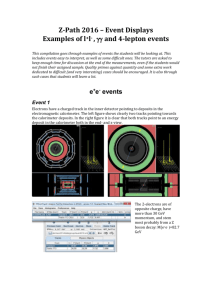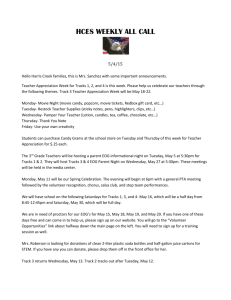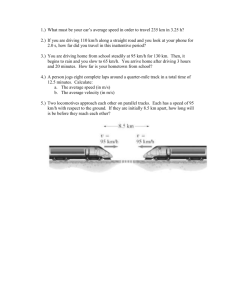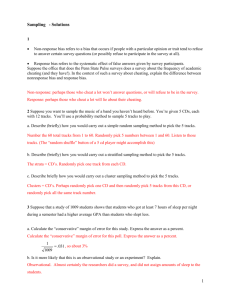event
advertisement
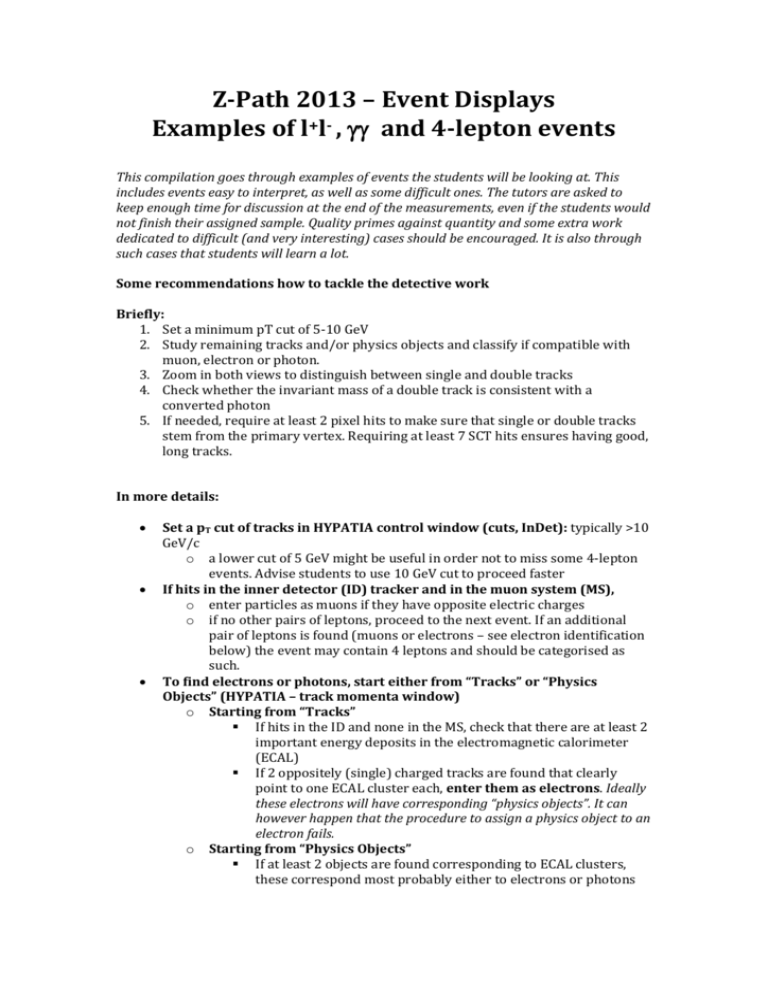
Z-Path 2013 – Event Displays Examples of l+l- , and 4-lepton events This compilation goes through examples of events the students will be looking at. This includes events easy to interpret, as well as some difficult ones. The tutors are asked to keep enough time for discussion at the end of the measurements, even if the students would not finish their assigned sample. Quality primes against quantity and some extra work dedicated to difficult (and very interesting) cases should be encouraged. It is also through such cases that students will learn a lot. Some recommendations how to tackle the detective work Briefly: 1. Set a minimum pT cut of 5-10 GeV 2. Study remaining tracks and/or physics objects and classify if compatible with muon, electron or photon. 3. Zoom in both views to distinguish between single and double tracks 4. Check whether the invariant mass of a double track is consistent with a converted photon 5. If needed, require at least 2 pixel hits to make sure that single or double tracks stem from the primary vertex. Requiring at least 7 SCT hits ensures having good, long tracks. In more details: Set a pT cut of tracks in HYPATIA control window (cuts, InDet): typically >10 GeV/c o a lower cut of 5 GeV might be useful in order not to miss some 4-lepton events. Advise students to use 10 GeV cut to proceed faster If hits in the inner detector (ID) tracker and in the muon system (MS), o enter particles as muons if they have opposite electric charges o if no other pairs of leptons, proceed to the next event. If an additional pair of leptons is found (muons or electrons – see electron identification below) the event may contain 4 leptons and should be categorised as such. To find electrons or photons, start either from “Tracks” or “Physics Objects” (HYPATIA – track momenta window) o Starting from “Tracks” If hits in the ID and none in the MS, check that there are at least 2 important energy deposits in the electromagnetic calorimeter (ECAL) If 2 oppositely (single) charged tracks are found that clearly point to one ECAL cluster each, enter them as electrons. Ideally these electrons will have corresponding “physics objects”. It can however happen that the procedure to assign a physics object to an electron fails. o Starting from “Physics Objects” If at least 2 objects are found corresponding to ECAL clusters, these correspond most probably either to electrons or photons Check tracks – zoom to distinguish single and double (very close) tracks – a track might seem to point to a cluster in the side-view but not in the end-view (or vice versa), so both views should be checked before classifying as electron/photon: If 2 (single) oppositely charged tracks are found pointing to an ECAL cluster each, enter them as electrons (ideal case as when starting from “Tracks” above) If no tracks are found pointing to 2 ECAL clusters, go back to “Physics Objects” and enter the objects as photons o Converted photons lead to close, oppositely charged tracks with very small invariant mass (compatible with the photon mass 0) 2 very close tracks pointing to one ECAL cluster may come from a converted photon (… e+e-). To check this, enter the 2 tracks as electrons and read the resulting invariant mass. In most cases M(ee) is very close to 0, such that you can go back to the “Physics Object” and enter the object as photon. In some cases the tracks disappear when requiring at least 2 pixel hits, see below, such that you are left with 2 isolated photons in the event. It may happen that a double track, proven to stem from a conversion, does not have a corresponding object. How to proceed? The current HYPATIA does not mix tracks and objects to build invariant mass. Enjoy the event and (unfortunately) ignore it … A Cut on “Number of Pixel Hits” >=2 may help getting rid of a single track or a double track (from a converted photon) that do not come from the primary vertex (main interaction point) A cut on “Number of SCT hits” >=7 may help having good, long tracks. 1. e+e- – events 1.1. Event 1 Electrons usually have a calorimeter object and a corresponding charged track. The left figure shows both tracks and calorimeter objects. In the left figure it is clear that both tracks point to an energy deposit in the calorimeter. The 2-electrons are of opposite charge, have more than 30 GeV momentum, and stem from a Z boson decay: M(e+e- =91.7 GeV 1.2. Event 2 Another event where a Z decays to a pair of e+e- The information about the calorimeter objects is reproduced below. The invariant mass is compatible with a Z boson M=88 GeV. One of tracks seems short; in fact it is emitted in the forward direction, as the z-view shows. 2. events 2.1. Event 1 This event has 2 calorimeter objects clearly without tracks pointing to them (left figure). After a pT cut of 5 GeV all tracks disappear (right). M()=110 GeV 2.2. Event 2 Another 2-photon event with 2 clear calo objects: M()=108 GeV. After a pT cut of 5 GeV, one track remains, which however does not point to the cluster in the z-view. In fact, by requiring 2 pixel hits, the track disappears (right figure). The requirement of pixel hits helps remove charged particles that weren’t produced at the collision point 3. A “difficult” event This event has 2 calorimeter clusters, one without any track pointing to it and one with a double track pointing to it (see zoom below). Assuming these are photons: M()=100.1GeV. Is this a 2-photon event? Study further! Let’s look at the 4 double tracks. The double track pointing to some calorimeter energy (with numbers 45-46, see below) have an invariant mass M(e+e-) =0.2GeV compatible with a converted photon! In fact this pair disappears when requiring at least 2 pixel hits (below right). What about the other pair remaining? It has no energy deposited in the calorimeter and both tracks have the same sign and can therefore be ignored. 4. Is this event or e+e-? Left: pT>1GeV; Right pT>5 GeV. The zoom below reveals 2 pairs of e+e-. The left pair disappears if at least 2 pixel hits are required (see pictures at bottom of page). Each pair has an invariant mass of ~0.1 GeV, i.e. consistent with a photon conversion! We are in presence of 2-photons, both converted. The invariant mass of the 4 electrons is ~134 GeV. Here is the calorimeter object information. The conclusion is that the 2 objects correspond to 2 photons, which have converted and lead to 4 tracks. One pair of tracks is rejected by requiring 3 pixel hits. 5. A event Muons are the easiest particles to recognise: hits in the muon spectrometer and in the inner detector, and very little activity in the calorimeter. This is an example of di-muon event from Z decay. Two tracks (89 and 117 have opposite charge) with hits in the muon spectrometer (both views). M(=84.3 GeV. 6. A 4-lepton event: This interesting event has 4 clear muons, stemming from ZZ : M(=94.1 GeV and M()=89.3 GeV. M(=373.5 GeV. One of the muons has hits only visible in the z-view. 7. A 4-lepton event: e+e- Another 4-lepton event stemming from ZZee with M(=91.1 GeV and M(ee)=89.6 GeV. There are 2 additional tracks, see further below. The 2 additional tracks (4 and31) with invariant mass Mee=1.2 GeV stem from a converted photon. In most cases such tracks disappear when requiring 2 or 3 pixel hits. If not, just ignore them. In fact a higher pT cut of 12 GeV (well justified) will get rid of them.
